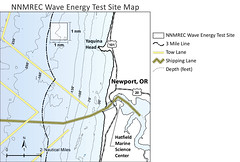 Michael Courtney and Annie Thorp, “intrepid volunteers” at OSU’s Hatfield Marine Science Center, are heading back out to sea to assist on not one, but two research cruises. And they’re reviving their blog, Buoy Tales, to chronicle their experiences.
Michael Courtney and Annie Thorp, “intrepid volunteers” at OSU’s Hatfield Marine Science Center, are heading back out to sea to assist on not one, but two research cruises. And they’re reviving their blog, Buoy Tales, to chronicle their experiences.
The Salem couple launched the blog (with help from Oregon Sea Grant) in 2010 to record their participation in a five-week cruise aboard OSU’s R/V Wecoma, servicing NOAA buoys along the equator that gather and transmit valuable data about ocean conditions. It was their second cruise as research volunteers.
Recently, Michael writes, they were asked on the same day to take part in two more cruises “so of course we said yes.”
They’ll depart Seattle this Friday (Aug. 29) aboard the Thompson, a research vessel operated by the University of Washington’s School of Oceanography. The ship’s mission is to recover an acoustic device sitting on Pioneer Mount, an undersea range off Half Moon Bay, Calif. The recovery cruise is expected to last until Aug. 9.
On Oct. 3, Annie and Michael ship out again on the R/V Wecoma for a cruise expected to last through Oct. 11.
To follow their adventures, visit the blog and subscribe to its RSS feed or sign up for email notification when new posts are published.






